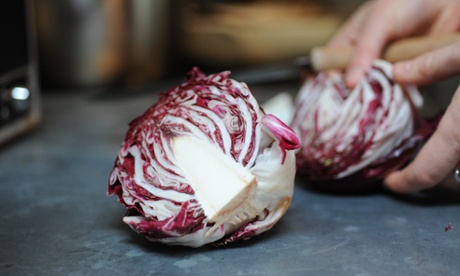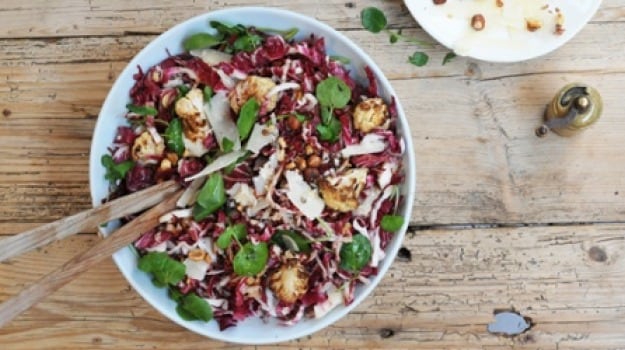Swap bags of prepared salad for fresh vegetable boxes to broaden your recipe repertoire and give yourself longer to use it all before it spoils. Some tips to get you started...
Bagged salad is a perfect example of the fallacy of convenience. All the work appears to have been done for you: prime leaves selected, washed and dried. All that's required is to shake it out of the bag and toss it with dressing. What could possibly be easier?
Yet what actually happens to bagged salad is that it sits in the fridge until the leaves have gone slimy, and then it gets chucked into the bin, unopened. An extraordinary 68% of all bagged salad produced for supermarkets is thrown away - some before it ever reaches the consumer, but mostly by people who bought it with every intention of turning it into a quick, healthy meal.
A bag of salad sitting in the fridge doesn't make you want to cook. It doesn't make you want to do anything, except close the fridge and call for a pizza. This is especially true in winter, when a person craves something more substantial than rocket and those strange frizzy mixed salad leaves that get caught in your throat and make you cough. But you know you ought to be eating more greens, so you keep buying the dreadful stuff - and letting it rot.

Here's my solution to the salad problem. I no longer buy it at all. Or, more accurately, I no longer choose what I buy. Instead, I get a weekly vegetable box, the contents of which I have no control over. At this time of year it's full of knobbly root vegetables and hardy greens - beetroot, kohlrabi, Jerusalem artichokes, parsnips, sprouts and cabbage. They last much longer than leaves in the fridge, and are far more versatile.
The danger with veg boxes used to be running out of inspiration. Unable to think what to do with a glut of parsnips, you'd let them languish at the back of the fridge before lobbing them guiltily in the bin with the bagged salad. But in the internet age, it's impossible to run out of ideas. Just Google "parsnips" and "salad" and you're off.
Although we tend to think of salad as a confection of soft leaves, the hardier winter vegetables do the job just as well - often better. Slicing them in interesting ways is important, so it might be worth investing in a mandolin: a salad of sliced kohlrabi or Jerusalem artichokes, each disc thin enough to shine a light through, is a fresh and beautiful thing.
I have started playing around with part-cooked salads, too: charring chunky slabs of radicchio on a hot griddle, for example, adds a honeyed sweetness to their bitter edge.
Colourful, crisp, and beautiful, these are salads with the right kind of bags of flavour. You may never want to make a dressed leaf salad again.
Warm cauliflower and radicchio salad
Preparation time: 10 minutes
Cooking time: 30 minutes
Serves 6
1 head of cauliflower
2 tbsp olive oil
1 tsp maple syrup
Salt and black pepper
For the dressing
1 tbsp white wine vinegar
1 shallot, finely chopped
3 tbsp olive oil
1 head radicchio, shredded
50g hazelnuts, toasted and crushed
A small bunch of watercress
Parmesan slivers
1 Set the oven to 170C/335F/gas mark 31/2. Break the cauliflower head into small florets. Toss in olive oil and maple syrup. Season well. Roast for about 30 minutes until browned and tender. Allow to cool for 10 minutes.
2 Whisk the vinegar, shallot and oil together to make the dressing. In a large bowl toss the cauliflower florets, radicchio and hazelnuts in the dressing. Season well.
3 Transfer to a serving dish and gently fold through the watercress. Top with slivers of parmesan.

Other winter salads
Raw jerusalem artichoke salad: Thinly slice and toss with chicory, parmesan slivers, lemon juice and truffle oil.
Leon kale caesar salad: Shred the kale very finely, then grate lashings of parmesan over the top. Dress with a mustard dressing (1 tbsp dijon mustard, 1/2 tbsp red wine vinegar, 200ml sunflower oil, salt and black pepper). Top the dressed salad with toasted sunflower, sesame and linseeds, and finely chopped mint and parsley.
Red cabbage and blue cheese salad: Soften sliced red onions in a little oil and add some balsamic vinegar and a little brown sugar. Add finely sliced red cabbage. Stir-fry for about 10 minutes until the cabbage is wilted. Season very well and add more vinegar to taste. Remove from the heat and add diced apple, chopped parsley, crumbled blue cheese and toasted walnuts.
Grated beetroot salad: Finely grate some raw beetroot. Dress with orange juice brought to a simmer with caraway and garlic. Season well. Toss with pieces of hot smoked salmon (or cold if you don't have hot) and watercress. Drizzle with a horseradish dressing (use the recipe in the kale salad, but replace the dijon mustard with horseradish sauce).
Roast squash and feta salad: Roast chunks of squash and beetroot pieces at 180C/350F/gas mark 4 for 20 minutes, or until cooked. Make a pistachio dressing with chopped nuts, chilli, balsamic vinegar and olive oil. Drizzle it over the vegetables. Crumble feta and pomegranate seeds on top.
Grilled radicchio salad: Cut the radicchio into 8 chunks (making sure that each chunk contains a bit of the stem to hold it together). Toss with olive oil, salt and pepper and char on a griddle pan on all sides. Dress while still warm with capers, lemon juice, whole anchovies, and olive oil if more is required.
Crunchy kohlrabi salad: Make sure the kohlrabi is nice and cold from the fridge for extra freshness. Peel it and slice it as finely as you can manage. Squeeze over fresh orange and lemon juice and a glug of olive oil. Season. This salad is lovely with a few good anchovies and some daintily chopped orange segments turned into it.
Recipes by Jane Baxter. Henry Dimbleby is co-founder of the natural fast-food restaurant chain Leon (@henry_leon)
There's no excuse for being stuck for ideas about what to make with your veg; a quick internet search is all it takes. Photograph: Jill Mead/Guardian










